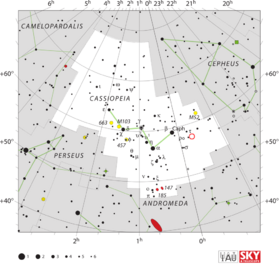Astronomy:V705 Cassiopeiae
| Observation data Equinox J2000.0]] (ICRS) | |
|---|---|
| Constellation | Cassiopeia |
| Right ascension | 23h 41m 47.19s[1] |
| Declination | 57° 30′ 59.5″[1] |
| Apparent magnitude (V) | 5.3[2] - 16.4[3] |
| Characteristics | |
| Variable type | Nova |
| Astrometry | |
| Distance | 2157+799 −228[3] pc |
| Other designations | |
| Database references | |
| SIMBAD | data |
V705 Cassiopeiae, also known as Nova Cassiopeiae 1993 was a nova which erupted in the constellation Cassiopeia during 1993. The nova was discovered at 11:17 UT on 7 December 1993 by amateur astronomer Kazuyoshi Kanatsu of Matsue, Japan, who photographed it using a 35mm camera with a 55mm f/2.8 lens.[5][6] Asteroid 6976 Kanatsu was named after him in honor of this discovery.[7] At the time of its discovery the nova had a photographic magnitude of 6.5. Around December 18, 1993, it flared briefly to magnitude 5.3 (making it visible to the naked eye), and then it returned rapidly to magnitude 6.5. It underwent a series of smaller flares until mid February 1993, after which it began a precipitous decline in brightness.[2]
The light curve of V705 Cassiopeiae showed a very pronounced "dust dip", and its brightness fell to about 16th magnitude in mid March 1994, before rebounding to about magnitude 12.5 where it stayed for about two years, after which it declined further. This dust dip occurs when dust forms as the material ejected in the nova explosion expands and cools.[8] The nova ultimately faded to a quiescent magnitude of 16.4.[3]
All novae are binary stars, with a "donor" star orbiting a white dwarf. The two stars are so close to each other that material is passed from the donor star to the white dwarf. The orbital period for the binary that forms V705 Cassiopeiae is 5.472 hours.[9] The white dwarf is estimated to have a mass of 1.05 M☉ and to be receiving 2×10−9 M☉ per year of material from the donor star.[10]
References
- ↑ 1.0 1.1 Cutri, Roc M.; Skrutskie, Michael F.; Van Dyk, Schuyler D.; Beichman, Charles A.; Carpenter, John M.; Chester, Thomas; Cambresy, Laurent; Evans, Tracey E. et al. (2003). "VizieR Online Data Catalog: 2MASS All-Sky Catalog of Point Sources (Cutri+ 2003)". CDS/ADC Collection of Electronic Catalogues 2246: II/246. Bibcode: 2003yCat.2246....0C. http://vizier.u-strasbg.fr/viz-bin/VizieR?-source=II/246.
- ↑ 2.0 2.1 Starrfield, S.; Hauschildt, P.H.; Shore, S.N.; Gonzalez-Riestra, R.; Sonneborn, G.; Allard, F. (1995). Cataclysmic Variables. Astrophysics and Space Science Library, vol 205. Dordrecht: Springer. pp. 267–275. ISBN 978-94-011-0335-0.
- ↑ 3.0 3.1 3.2 Schaefer, Bradley E. (December 2018). "The distances to Novae as seen by Gaia". Monthly Notices of the Royal Astronomical Society 481 (3): 3033–3051. doi:10.1093/mnras/sty2388. Bibcode: 2018MNRAS.481.3033S.
- ↑ "V705 Cas". SIMBAD. Centre de données astronomiques de Strasbourg. http://simbad.u-strasbg.fr/simbad/sim-basic?Ident=V705+Cas.
- ↑ Nakano, S.; Kanatsu, K.; Kawanishi, K.; Tago, A.; Otomo, S.; Urata, T.; Tomita, K. (December 1993). "Nova Cassiopeiae 1993". IAU Circular 5902: 1. Bibcode: 1993IAUC.5902....1N.
- ↑ "Alert Notice PEP #00: Special Alert Notice to AAVSO Photoelectric Observers [2337+56 Nova Cassiopeiae 1993 [V705 Cas]"]. AAVSO. https://www.aavso.org/aavso-alert-notice-pep-00.
- ↑ "6976 Kanatsu (1993 KD2)". NASA/JPL. https://ssd.jpl.nasa.gov/sbdb.cgi?orb=1;sstr=6976.
- ↑ Shore, S.N.; Starrfield, S.; Gonzalez-Riestrat, R.; Hauschildt, P.H.; Sonneborn, G. (June 1994). "Dust formation in Nova Cassiopeiae 1993 seen by ultraviolet absorption". Nature 369 (6481): 539–541. doi:10.1038/369539a0. Bibcode: 1994Natur.369..539S.
- ↑ Diaz, M.P.; Bruch, A. (June 1997). "The orbital period distribution of novae". Astronomy and Astrophysics 322: 807–816. Bibcode: 1997A&A...322..807D.
- ↑ Shara, Michael M.; Prialnik, Dina; Hillman, Yael; Kovetz, Attay (June 2018). "The Masses and Accretion Rates of White Dwarfs in Classical and Recurrent Novae". The Astrophysical Journal 860 (2): 110. doi:10.3847/1538-4357/aabfbd. Bibcode: 2018ApJ...860..110S.
 |



